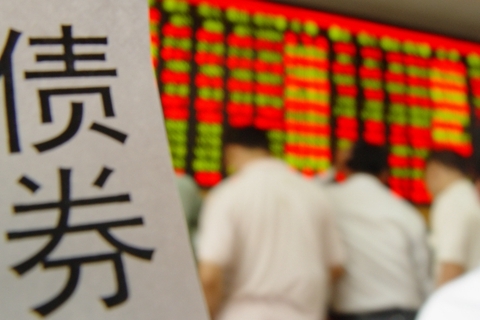Caixin Explains: China’s Developing Junk Bond Market

China’s wave of bond defaults is good news for at least a small fraction of investors in the world’s second-largest bond market — those hunting profits from riskier, junk-rated debt.
“The default wave is creating an unprecedented opportunity,” declares an online marketing pitch for a bond investment training institution. The piece highlights the possibility of multi-fold returns.
“People are flooding into the (junk bond) market,” a bond market investor said.
Also known as high-yield bonds, junk bonds are debt instruments with credit ratings lower than investment-grade corporate, Treasury and municipal bonds. But contrary to their name, some of these bonds provide viable investment options for investors capable of managing the risks.
China’s junk bond market has heated up this year as the nation’s bond issuers are on the way to setting another record for annual defaults. According to Bloomberg, Chinese companies have defaulted on 130.7 billion yuan ($18.7 billion) of domestic bonds so far this year, surpassing 2018’s full-year record of 122 billion yuan.
Some of the defaulted bonds were eventually paid off and generated hefty returns for investors. For instance, returns for bondholders of Kangmei Pharmaceutical Co., a drugmaker shaken by one of China’s biggest accounting scandals, jumped four-fold in a month for those who invested at the height of the company’s crisis.
“Some institutions have started testing the waters in high-yield bond investment,” a bankruptcy lawyer said. Most of the funds he works with are relatively small, with total investments in the tens of million yuan, the lawyer said.
A brokerage house researcher who asked not to be named said his company set up a 100 million yuan fund in late 2018 to invest in junk-rated debts and has booked an average return of 20%.
Still, junk bond investment is a fledgling part of China’s massive bond market. A private equity partner said less than 5% of the capital managed by his 20 billion yuan of funds are from investors who truly understand junk bond investment.
Regulators are studying the expanding segment as it will help create a more diverse bond market to better reflect borrowers’ creditworthiness in pricing and more effectively deal with souring assets. Rong Yihua, an official at the central bank’s Shanghai branch, said in a recent article that a well-developed junk bond market will help medium and small companies, especially startups, to get easier funding through bond sales based on reasonable pricing and proper disclosure.
Despite warming enthusiasm, many bond market investors and experts said they are still cautious about junk bond investment and warned that the market is far from ready.
“There are a series of issues that need to be resolved from investors’ qualification, trading system arrangement to default disposal,” a bond market investor said.
“The high-yield bond market is still at a very early stage, and it is too early to talk about investment portfolio,” the investor said.
A precondition for the junk bond market to grow is to cultivate investors who can properly manage the related risks, others said.
Here are answers to five central questions about China’s developing junk bond market.
How are junk bonds defined and how big is China’s junk bond market?
By international standards, junk bonds are typically rated BB or lower by Standard & Poor's and Ba or lower by Moody's. But in China, the definition of junk bonds is more opaque because of the lack of a commonly accepted benchmark for credit ratings. Many investors have criticized the country’s rating companies for being too generous in issuing bond ratings, failing to reflect the real credit quality of issuers and their notes.
In China, “everyone has their own criteria” for junk bonds, a private equity investor said. For instance, some institutions define junk bonds by comparing yield rates with certain benchmarks, such as bonds issued by China Development Bank (CDB), while others use discount rates as measurements.
That makes it difficult to assess the actual size of China’s junk bond market, and many institutions have their own estimates. Guosheng Securities defines junk bonds as those with ratings below AA+ and yields exceeding CDB bonds by 500 basis points, or 5 percentage points. By that standard, Guosheng estimates the outstanding value of China’s junk market at 477 billion yuan as of Oct. 25.
Another private investment fund said a calculation based on bond maturity and yield rates put the junk bond market at 409 billion yuan at the end of November, or about 2.3% of China’s nongovernment bonds.
Citic Securities said junk bonds should not be simply defined based on yield. Instead, the brokerage classifies bonds priced below 80 yuan as junk. According to Citic, there were 103 bonds, or 0.45% of China’s 23,056 outstanding nongovernment bonds, with a price below 80 yuan as of May 8.
No matter how it is calculated, China’s junk bond market is still a small slice compared with those in developed countries. According to the central bank’s Rong, outstanding junk bonds in the U.S. totaled $1.2 trillion at the end of 2018, about 13.1% of the country’s corporate bond market and 2.8% of the entire American bond market.
Who are the main junk bond issuers?
In developed markets like the U.S., there are usually four types of junk bond issuers: startups that are growing quickly but have yet to achieve sound financial performance, companies with stable business operations but high debt ratios; enterprises that have been downgraded because of business difficulties and businesses with low ratings after leveraged acquisitions or restructurings.
Among Chinese bond issuers, indebted property companies that are restricted from major borrowing channels are the main group of junk bond issuers, especially dollar-dominated debt. According to a study by China Chengxin International Credit Rating Co. Ltd., of 174 Chinese companies that issued dollar-dominated bonds during the first half of 2019, more than half were property companies. In October, Chinese developer Kaisa Group issued its fifth batch of junk-level bonds in dollars with yields at 12.35%.
Borrowing demand has pushed up average coupon rates of China-backed dollar bonds to 6.32%, according to China Chengxin.
Who are the main investors in China’s junk bond market?
Investors in the junk bond market include passive participants whose bond holdings were downgraded to junk level and proactive investors who seek profits from the risker but higher-paying notes.
Ping An Securities divides proactive junk bond investors into three categories: institutions that actively seek profit opportunities from individual bonds such as private equity funds, asset managers and mutual funds; investors tapping the junk bond market through structured products such as exchange-traded funds (ETFs) and collateralized debt obligations (CDOs); and bad-loan managers who focus on default disposal.
In China, most junk bond investors fall into the first and third categories as they either invest in individual bonds or take part in default disposal. The second type of structured high-yield product investors is rarely seen in China, Ping An said.
As of early November, China had 93 outstanding asset management products focusing on high-yield bonds, including 32 managed by fund companies, 28 by private equities, 16 by brokerages, 10 by banks and 5 by mutual funds. The remaining two were one managed by an insurance company and one for investors eligible for the Renminbi Qualified Foreign Institutional Investor (RQFII) program, according to Ping An.
What are the main strategies for junk bond investment and do they fit the Chinese market?
Theoretically, investors can profit from a junk bond investment by holding it until maturity to collect the higher-than-average yield, or by trading it on the secondary market when bond price rises with an issuer’s improving credit rating, or by earning a margin between repayment in default disposal and the discounted price they paid for the bond.
But in China, the long-standing expectation of government bailouts to prevent bond defaults has played a crucial role in investors’ junk bond investment decisions.
One brokerage researcher said his firm raised funds from a number of private entrepreneurs to invest in around 20 junk-rated bonds over the past year, and all of the bonds were repaid eventually after investors worked with local governments to support the bonds.
Several bond-market investors said buying junk bonds is mainly a gamble on whether local governments will offer a rescue. There is no unified investment strategy or logic to follow, and investors have to search for internal information regarding each bond, one investor said.
The implicit government guarantee has kept the overall default rate in China’s bond market at a low level, but it distorts market pricing based on risks and creates room for arbitrage, Ping An Securities said in a research note.
What are the main obstacles for development of China’s junk bond market?
The lack of an efficient and transparent default disposal mechanism is holding back many investors in the junk bond market in China as it exposes them to greater uncertainties about repayment, experts said.
Tianfeng Securities research on the bankruptcy cases of 31 bond issuers since 2014 found that most of the companies took a very long time to work out a clear debt restructuring plan, and bondholders often waited even longer to be repaid.
A bankruptcy lawyer said that although the law requires bankruptcy proceedings to be completed in no more than nine months, actual progress for most companies takes much longer.
Some investors are also concerned about whether they can be treated fairly in default disposal as creditors are often represented by big banks in China. In many bankruptcy cases, banks played the role of bond investors and lenders as well as financial service providers for the troubled companies. The close business ties between banks and debtors raised doubts over whether other creditors’ rights can be fairly protected, one investor said.
The development of China’s junk bond market needs a better bond default disposal system to protect all investors’ legal interests, Rong of the central bank said. It requires a more efficient judiciary procedure to handle default cases, a market-oriented risk disposal mechanism and the establishment of a trading system for defaulted bonds, Rong said.
Contact reporter Han Wei (weihan@caixin.com)
Caixin Global has officially launched Caixin CEIC Mobile, a mobile-only version of a world-class platform for macroeconomic and microeconomic data.
From now on, all users can enjoy a one-month free trial on the Caixin App through December 2019. If you’re using our App, click here. If you haven’t downloaded the App, click here.

- MOST POPULAR





